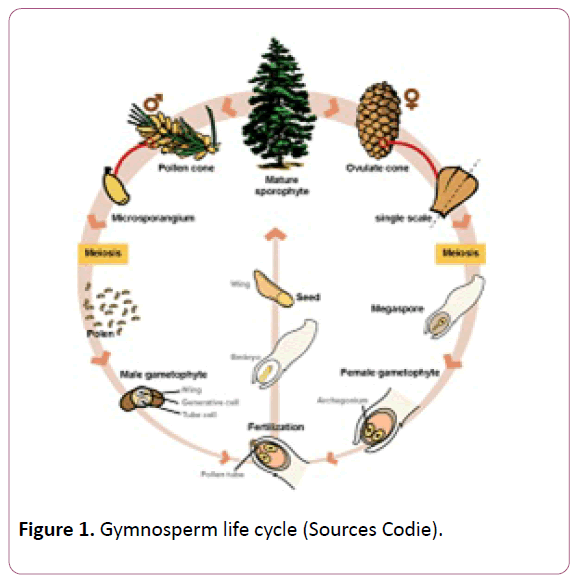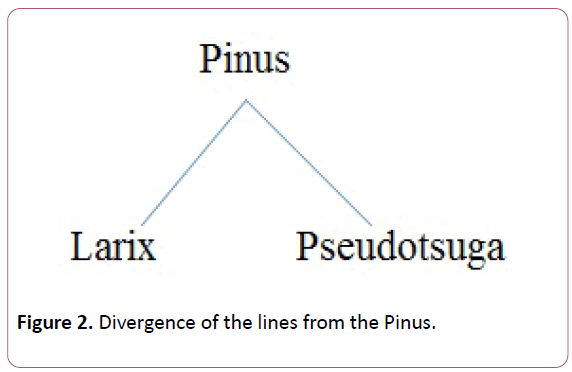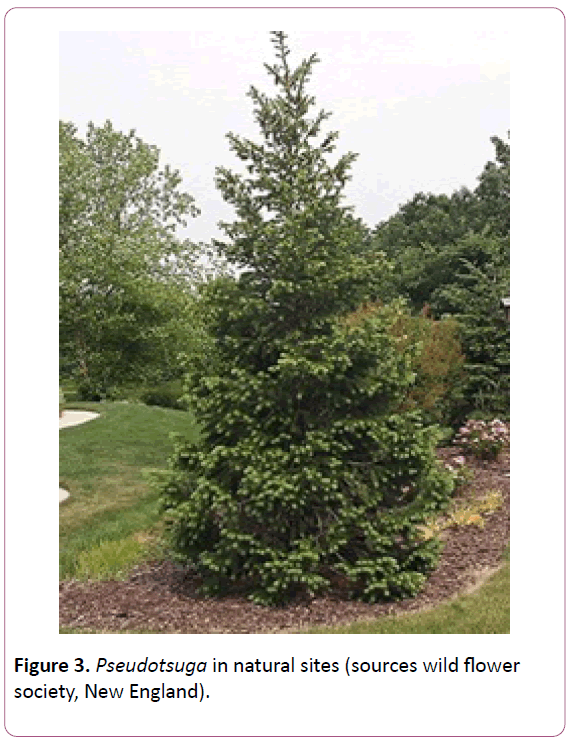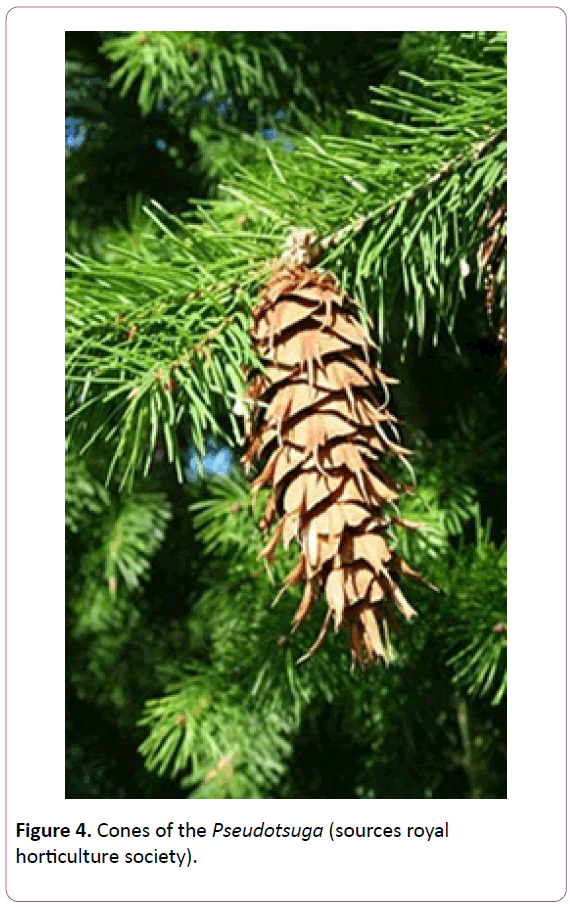Keywords
Conservation; Pseudotsuga; Degradation; Dominant; Ecosystem
Introduction
Gymnosperms are the naked seed plants, in which seeds are not enclosed in the fruits. The naked seed can found on the megasporophyll on the female cones. The cones can be found of the different sizes and shapes which is the features of the taxonomic importance [1,2]. They Varies from the few mm to the some large cm (in coniferals). The sizes of the megasporophyll and the cones are the features of the great taxonomic importance. The whole of the gymnosperms has been classified into the different classes by the various systems of the classifications. However some of the recognized classes can be enlisted as:
• Extinct pteridospermales
• Extinct Bennettitales
• Extinct cordaitales
• Cycadophyta
• Coniferophyta
• Ginkgophyta
• Gnetophyta
The gymnosperms gas the long fossil history; they were abundant in the Mesozoic era, in the early Triassic period of the plant evolution a line of the cladistics arose in the direction of the evolution of the Cycadales, however the maximum development of the coniferales has been observed in the middles Jurassic and the cretaceous period [1-7]. After the dawn of the Mesozoic era there were the rapid declines in the vegetation the gymnosperms. In the Cenozoic era one can see the development of the angiosperms (Figure 1) [1-3,5,7].

Figure 1: Gymnosperm life cycle (Sources Codie).
Till now around 84 genera’s and the 1000 species of the gymnosperms has been reported from all over the globe. Cycadales are the living representatives of the extinct lines of the evolution of the gymnosperms which were very well in the Mesozoic era; all of the living 11 genera’s of the Cycadales has been termed as the living fossils.
They have now very restricted distribution in the globe [1-3].
Coniferales are the most abundant and diverse group of the gymnosperms. They are widely distributed in all over the globe. In India the Himalayas have the long belt of the distribution of the coniferales. In India, Uttarakhand is the area of the distribution and endemism of the gymnosperms [1-3].
However, in America and the other part of the world there is a long continuous belt of the conifers gymnosperms. It is known as the conifer lines. A large forest of the coniferales can be seen over there. Coniferales have the adaptations towards the all types of the climates, they can be seen from the snowy, xeric conditions and they can sustain in the huge winds storms. The morphological and anatomical and physiological nature of the coniferales shows the adaptations towards the xeric and the harsh conditions.
Coniferales have the following features:
• The sizes of the trees vary from the small to the large ones (sequia spp. largest in the world).
• The roots of the trees are deep seated and of different kinds of nature. Generally they are ephemeral in the early ontogeny later on large tufts of the adventitious roots can be observed. They are deep seated and widely distributed.
• Leaves are generally of the needles, they are generally covered with the waxy coating, and the deposition of the waxes shows the adaptations towards the different kinds of the climates.
• Stem is the long branched, have the bark, and in early coniferales two kinds of the shoots has been observed, long shots and dwarfs shoots, a typical pattern of the secondary growth can be seen on the stem. However, the vessels and the sieve tube cells are absent in the trunk and roots anatomy [2,3,5,6].
• Reproduction occur by the cones, separate sexes can be seen in different cones, male sexes and females sexes are different, however in some cases the monoecism conditions can be observed. Cones are woody and large. In some cases they approached the height of the few meters. They have the arrangement of the spiral sporangia in groups, which have the many hair like projections for the protection and the wetting purposes. Female cones also have the many ovules of the developing orders [1-6].
However the gymnosperms are declining with the great speeds. They have been used by the trials and the other peoples for the variety of the purposes, wood of the all coniferales are of the great importance. They have been utilized for the timber and the other constructions. Habitat destructions, continuous cuttings without proper propagation is the main reasons for the degradation of the plants.
In this review articles we are trying to incorporate all features of the Pseudotsuga plants.
Distribution
Pseudotsuga can found widely in the natural ranges of the northern America, a long coniferous belt can be seen over there. In majority of the forest ranges of the North America it forms the dominant vegetation’s [1-7].
The all aspects of the Pseudotsuga have been studied by lavender [1-6]. They have studied the all features of the Pseudotsuga. Some of the points of the Pseudotsuga have been taken from the monograph of the lavender and Herman [7].
The genus includes around 12 species all lover the world. Among them some of them are endemic to The United States and Canada [2,3,7], four species are endemic to Mexico [2,3,7], four are endemic to china, one is endemic to the Taiwan, one endemic to Japan [2,3,7].
Pseudotsuga has been termed as the Douglas fir. It belongs to the family pinaceae. All the species of the Douglas fir has the diploid chromosome number (Doerken & China). The genome of the Pseudotsuga has always been the points of the interest for the various research purposes (Neal et al). They show the conserved methods of the evolution.
The genera are the Monoeious; both sexes are found on the same plants. Generally the methods of the pollinations are by the winds from the different cones.
Fossil records of the Pseudotsuga have been found in the late carboniferous period [7]. It has been found that a cladistics lines of the evolution diverges in the late carboniferous period [2,7]. The fossil s remains of the Pseudotsuga have been found in the Russia and Mexico.
Cytological investigations of the Pseudotsuga has been studied by Szilail team [2,3,7]. They show the phylogeny of the gymnosperms Pseudotsuga by the all kinds of the cytological investigations.
Evolution of the Pseudotsuga has been investigated by Staruss et al, using RFLP of chloroplast, nuclear and mitochondrial DNA as a molecular tool. They enlisted the following species of the Pseudotsuga.
• P.Meiziessi
• P.macrocarpa
• P.Japonica
• P.wilsponiana
• P.Sinensis
On the basis of the phylogeny it was concluded that first Pseudotsuga evolved in the North America, later on lines of the evolution diverge in the different directions [7], which leads to the establishment of the Pseudotsuga in the different geographic areas.
Tertiary fossils has been recorded form by the Alaska [2,7], pollen deposit of the Pseudotsuga has been found in the lower cretaceous times in eastern Gobi, Mongolia.
On the basis of the morphological, anatomical and cytological investigations two main hypothesis has been proposed for the evolution of the Pseudotsuga., one hypothesis says that one lines of the evolution goes from the Pinus to the Pseudotsuga, it diverge in to the two lines one in the development of the Lasix and the other cladistics lines of the evolution in the Pseudotsuga (Figure 2) [2,7].

Figure 2: Divergence of the lines from the Pinus.
The another hypothesis says that another lines’ of the evolution goes from the larix lines of the evolution, in that case Larix has produced the Pinus liens of the evolution, from them Pseudotsuga like cladistics arises [2,3,7].
The close relationship between the larix and the Pseudotsuga has been observed by the chromosomal studies [7]. Some morphological and the anatomical similarities has been observed in both of the genera‘s [2,3,7].
Pseudotsuga has been observed in the voyage by one of the English person Archibald Menzies (1754-1842) (Figures 3 and 4) [2,3,7].

Figure 3: Pseudotsuga in natural sites (sources wild flower society, New England).

Figure 4: Cones of the Pseudotsuga (sources royal horticulture society).
Introduction of the Pseudotsuga the different part of the world occur by the different means [2,3,6,7]. Phytochemical aspects of the Pseudotsuga has been investigated in franco Romania [2,3,6,7]. The composition of the needles and young shoots essential oils in Douglas fir needles from different part of the plants has been observed [2,3,6-8]. The extraction of the essential oils has been done using the neocleavenger type apparatus. The analysis of the oil has been done by the GS-MS system. The major contribution of the oils follows as: sabiene, terpinolene, terpinenes, beta pinene, alpha terpene, alpha piene in various concentration due to different vegetative organs and the differ kinds of the climatic conditions ecotypes [2,3,6,7]. Some of the oleoresins of the great complexity and the glycosides has also been reported in the genus [2,3,6,7]. Douglas fir great for the various purposes by the tribes of the North America peoples who used the plants for the variety of the purposes [3,6-8].
Some of the uses of the Pseudotsuga have been enlisted as:
• An antiseptic resin is obtained from the trunk.
• The resin is used for the variety of the purposes; these uses are cuts, burns, wounds, and other skin ailments.
• The resin is used for the treatments of the cough and can be used for the treatment of the throats.
• Infusion of the green bark has been used in the treatment of the menstruation problem, bleeding bowels, and stomach problems.
• The leaves have been used for the treatment of the rheumatoid arthritis.
• The young sprouts have been used for the treatment of the cold.
• A decoction of the shoots has been used for the treatment of the urinary and the bladder problems.
• A number of the other applications also can be written.
Threats and Conservation of the Pseudotsuga
These decades one can observe the Pseudotsuga rapid declines in the different part of the world. In India during the 1900 to 1950 there were long belt of the Pseudotsuga forest in the Himalayas mountain series and in the Uttarakhand, now a rapid degradation in the forest vegetation can be observed. The plant is valuable from the variety of the purposes from roots to the shoots. Indian ministry of the forest and environment should take the serious majors for the protection of the degrading Pseudotsuga vegetation. These efforts should be internationally, than only declining vegetation of the threatened Pseudotsuga can be saved [3,6,7]. IUCN on the basis of the area of the occupancy and the area of the presence declared the species as the endangered and need conservation and protection.
References
- Frankis MP (2003) Arboretum de Villardebelle: Images of Pseudotsuga species cones.
- Carrière R (1867) The Gymosperm Database: Pseudotsugalindleyana.
- Carrière R (2006) Gymnosperm Database: Pseudotsugamenziesii var. menziesii.
- Peng Li, Adams WT (1989) Rangewide patterns of allozyme variation in Douglas-fir. Canad J Forest Res 19: 149-161.
- Little EL (1952) The genus Pseudotsuga (Douglas-fir) in North America. Leafl Western Botany 6: 181-198.
- Carrière E (2012)Flora of China: Pseudotsuga.
- Denis P, Hermann RK (2014) Douglas-fir: The Genus Pseudotsuga. Oregon Forest Research Laboratory, Oregon State University, Corvalli.
- Farjon A (2013) Pseudotsugamacrocarpa. The IUCN Red List of Threatened Species.





